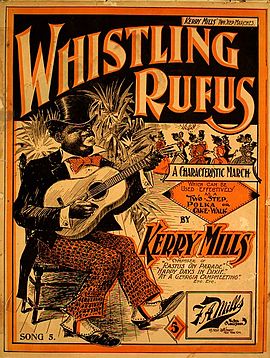Annotation:Whistling Rufus
X:233
T:Whistling Rufus
R:Cakewalk
C:Kerry Mills (1899)
Z:added by Alf warnock alf0@rogers.com - www.alfwarnock.info/alfs
M:C|
L:1/8
K:G
P:A
|:G2GB d2de|g2g2 ed3|G2GA BAG2|d8|\
G2GB d2de|g2g2 ed3|a2aa age2|a8|
G2GB d2de|g2g2 ed3|G2GA BAG2|d6g2|\
eg2e d2ed|B2G2 AGED|GB2G AGA2|[1 G2z2 g2z2:|[2 G2B2 F2G2||
P:B
|:d4d4-|d2e2d2G2|F4F4-|F2 c2^G2A2|\
e4e4-|e2f2e2c2|B4B4-|B2B2F2G2|
d4d4-|d2e2d2G2|c4c4-|c2d2c2G2|\
B4c2B2|E4F4|[1G8-|G2B2F2G2:|[2 G8-|G4g2z2||
P:A
G2GB d2de|g2g2 ed3|G2GA BAG2|d8|\
G2GB d2de|g2g2 ed3|a2aa age2|a8|
G2GB d2de|g2g2 ed3|G2GA BAG2|d6g2|\
eg2e d2ed|B2G2 AGED|GB2G AGA2| G2z2 g2z2|
K:C
P:C
|:c6d2|e6g2|a3ba3b|a2g2e2c2|\
d3ed3e|d2A2B2c2|d3ed2e|d2B2A2G2|
c6d2|e6g2|a3ba3b|a2g2e2c2|\
d3ed3e|d2A2B2c2|[1 d8|c4G4:|[2 d8|c2e2B2c2||
P:D
|:g4g4-|g2a2g2c2|B4B4-|B2f2 ^c2d2|\
a4a4-|a2b2a2f2|e4e4-|e2e2B2c2|
g4g4-|g2a2g2c2|f4f4-|f2g2f2c2|\
e4f2e2|A4B4|[1 c8-c2e2B2c2:|[2 c8-|c4c'2z2|]

No cakewalk given in the Black Belt district of Alabama was considered worth while attending unless “Whistling Rufus” was engaged to furnish the music. Unlike other musicians, Rufus always performed alone, playing an accompaniment to his whistling on an old guitar, and it was with great pride that he called himself the “one-man band.”
Cauthen (1990), however, calls it a minstrel composition that passed into fiddling tradition, although on what authority she suggests the predating of Mills is not known. Arizona fiddler Kenner C. Kartchner identified it as a "good two step from around 1900" (Shumway). It was played by Rock Ridge, Alabama, fiddlers around 1920 and it appears in a list of traditional Ozarks Mountains fiddle tunes compiled by musicologist/folklorist Vance Randolph, published in 1954. It is also played as a fast breakdown by bluegrass musicians. Stacy Phillips (1995) notes that the first section is sometimes bowed right next to the bridge, resulting in a whistle-like tone. The tune was in the repertoire of West Virginia fiddler Edden Hammons. It was recorded on a cylinder record in 1899 by Vess L. Ossman, the pre-eminent banjo player of the 1890’s, nicknamed “The Banjo King.” Early 78 RPM recordings include Gid Tanner & Riley Puckett (1924), Ernest Thompson (1924), McLaughlin’s Old Time Melody Makers (1928), the Kessinger Brothers (1929) and Arkie the Arkansas Woodchopper (1941) [see Guthrie Meade,Country Music Sources, 2002]. See also related melodies “Old Parnell Reel” and “North Carolina Breakdown.”
“Whistling Rufus” was popularized in Scotland and Ireland by Scottish accordion player and dance-band leader Jimmy Shand, who recorded it in the 1950’s.
